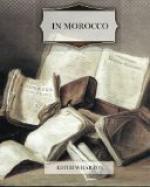Inside the gate of the Kasbah one comes on more waste land and on other walls—for all Moroccan towns are enclosed in circuit within circuit of battlemented masonry. Then, unexpectedly, a gate in one of the inner walls lets one into a tiled court enclosed in a traceried cloister and overlooking an orange-grove that rises out of a carpet of roses. This peaceful and well-ordered place is the interior of the Medersa (the college) of the Oudayas. Morocco is full of these colleges, or rather lodging-houses of the students frequenting the mosques, for all Mahometan education is given in the mosque itself, only the preparatory work being done in the colleges. The most beautiful of the Medersas date from the earlier years of the long Merinid dynasty (1248-1548), the period at which Moroccan art, freed from too distinctively Spanish and Arab influences, began to develop a delicate grace of its own as far removed from the extravagance of Spanish ornament as from the inheritance of Roman-Byzantine motives that the first Moslem invasion had brought with it from Syria and Mesopotamia.
These exquisite collegiate buildings, though still in use whenever they are near a well-known mosque, have all fallen into a state of sordid disrepair. The Moroccan Arab, though he continues to build—and fortunately to build in the old tradition, which has never been lost—has, like all Orientals, an invincible repugnance to repairing and restoring, and one after another the frail exposed Arab structures, with their open courts and badly constructed terrace-roofs, are crumbling into ruin. Happily the French Government has at last been asked to intervene, and all over Morocco the Medersas are being repaired with skill and discretion. That of the Oudayas is already completely restored, and as it had long fallen into disuse it has been transformed by the Ministry of Fine Arts into a museum of Moroccan art.
The plan of the Medersas is always much the same: the eternal plan of the Arab house, built about one or more arcaded courts, with long narrow rooms enclosing them on the ground floor, and several stories above, reached by narrow stairs, and often opening on finely carved cedar galleries. The chief difference between the Medersa and the private house, or even the fondak,[A] lies in the use to which the rooms are put. In the Medersas, one of the ground-floor apartments is always fitted up as a chapel, and shut off from the court by carved cedar doors still often touched with old gilding and vermilion. There are always a few students praying in the chapel, while others sit in the doors of the upper rooms, their books on their knees, or lean over the carved galleries chatting with their companions who are washing their feet at the marble fountain in the court, preparatory to entering the chapel.
[Footnote A: The Moroccan inn or caravanserai.]
[Illustration: From a photograph by Schmitt, Rabat
Rabat—interior court of the Medersa of the Oudayas]




